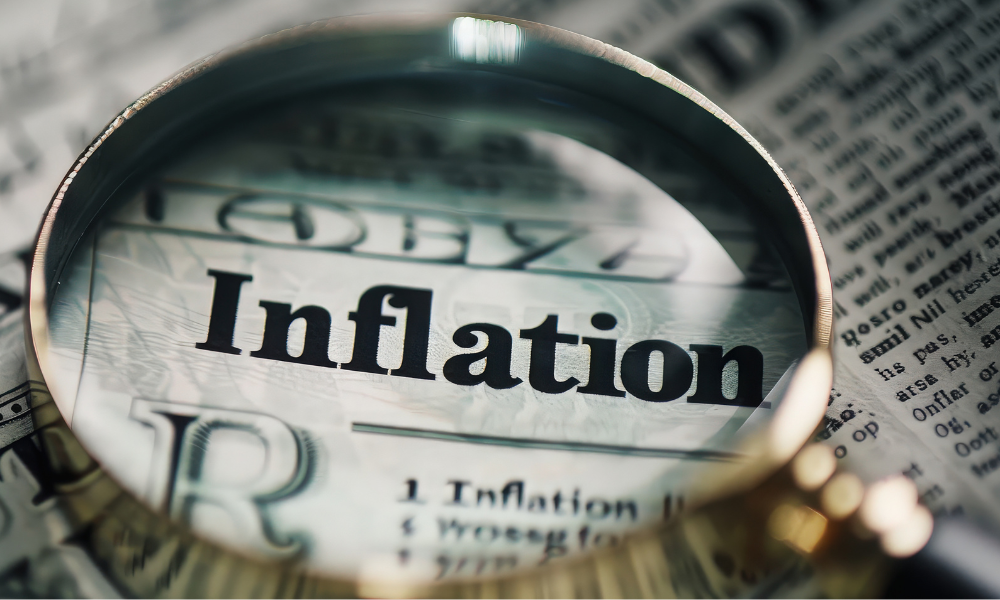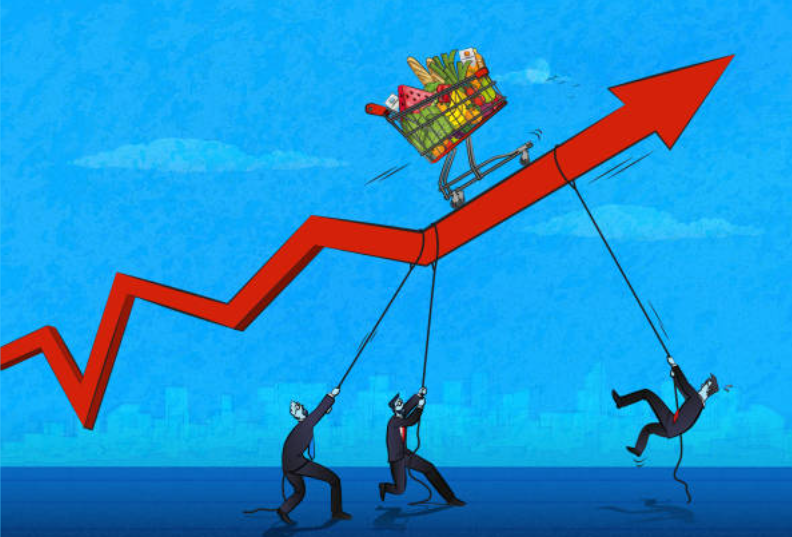Inflation rates have always been fluctuating in the US. Want to understand its impact on the economy? Here is everything you need to know about inflation rates

The current rate of inflation in the United States is 2.4% for the 12 months ending March 31, 2025, down from 2.8% the previous month.
In this article, Mortgage Professional America will discuss everything you need to know about inflation rates. We will discuss how it could impact the US economy and how the Federal Reserve typically responds to ballooning inflation. We will also discuss how inflation rates are calculated and answer why US inflation is so high.
What is inflation?
Inflation is when the purchasing power of a currency decreases over time. That declining purchasing power can be reflected in the increase in the average price level of certain goods and services in the economy during the same period. In the US, if the buying power of the dollar weakens, it means that inflation is high.
Inflation rates
Inflation rates are expressed in percentages. The increase in costs means that the US dollar purchases less than it did during previous quarters. On the other hand, deflation occurs when prices decrease and the buying power of money increases.
The goods and services that inflation usually affects are commodities like the following:
- fuel
- food
- metal
- grains
Utilities such as water, electricity, and transportation are also affected when inflation rates are high. The same goes for services including:
- labor
- health care
- entertainment
Generally, the root cause of inflation is a rise in the supply of money. An increase in money supply may occur when authorities print more physical money and give away more, or legally reduce the value of the currency.
It can also happen when they buy government bonds from banks on the secondary market after loaning new money as reserve account credits through the banking.
In both of these cases, money loses some of its buying power.
Watch this video to better understand US inflation rates:
Want to understand how inflation rates can affect the mortgage sector? You can talk to any of the industry experts on our Best in Mortgage page.
How are inflation rates calculated?
Inflation rates are calculated by measuring the changing value of a particular currency over time. This is reflected in the changing costs of the goods and services that consumers pay for. Calculating inflation rates enables you to see how quickly costs rise over a certain period. Here are three different ways inflation is measured:
- by location and currency
- using the price index or CPI
- through index numbers
Let’s find out how inflation rates are determined by discussing each computation method further:
1. By location and currency
While inflation is calculated on a country-by-country basis, it can also be done locally by comparing the inflation rate of a city to the inflation rate of the country. Inflation rates can also be compared from one country to another. However, when comparing inflation rates between countries, it is important to be aware of the differences between currencies. For instance, British pounds and US dollars.
Photo alt text (not a caption, so this should not appear on the web page): the purchasing power of the US dollar is used to calculate inflation rates
2. Using the price index or CPI
Consumer Price Index (CPI) data is a commonly used inflation formula. Each country produces its own CPI. Within that context, different regions and cities produce their own data. The CPI will give you an average of a basket of goods that are usually bought by the population.
There are also industry-specific indexes. For example, the Construction Cost Index (CCI) is used to calculate inflation for a cost estimate on a building project.
Watch this video to better understand how inflation rates are calculated using the CPI:
3. Through index numbers
The US inflation rate is always measured over a specific period. This can be through:
- decades
- years
- months
All you need to calculate inflation is a beginning and ending point within that timeframe. You can then correlate those numbers using the CPI chart you are using, with the results providing you with a picture of how fast costs rose during that time.
For instance, to measure inflation for a year, you would take the CPI number from the year prior and the CPI number for the target year. The rate will be how fast costs rose during that period.
How do inflation rates impact the economy?
Inflation impacts different economies in several ways–both good and bad. If inflation causes the US dollar to drop, it could be positive news for exporters. This is because it makes their goods and services more affordable when compared to the currency of other countries. On the other hand, inflation can negatively impact importers because foreign-made goods and services will become more expensive.
Price increases across the board are mostly bad news for buyers. Inflation can sometimes encourage spending if consumers want to buy goods and services before costs go up even more.
Those who tend to save might see the value of their savings drop. This limits the ability to invest or spend in the future.
How does the Federal Reserve typically respond to inflation?
The central bank of the US or the Federal Reserve sets monetary policy with tools that attempt to lower and stabilize inflation. This is largely accomplished through raising or lowering its interest rate. As a result, it impacts both the amount of money people receive in their savings and the fees they need to pay on their mortgages and loans.
When the central bank raises interest rates, it generally encourages people to save. Obviously, the response of the consumers will be to spend less.
Policymakers with the Federal Reserve monitor several different price indexes. These measure changes in the costs of a group of goods and services when evaluating changes in inflation. The Fed considers this variety since different price indexes track different products and services. Another reason is that each index can be calculated uniquely. This means that specific indexes can send different signals about inflation.
Watch this video on why the Federal Reserve controls so much of the US economy:
What is the highest inflation rate in the US?
The highest inflation rate in the US was 29.78% in 1778. When the CPI was introduced, the highest inflation rate was 20.49% in 1917.
What is the inflation rate for the last 5 years?
When the globe was shaken by the COVID-19 pandemic, the inflation rates quickly rose in all parts of the world. In 2022, the US Bureau of Labor Statistics had recorded an 8% inflation rate as more people lost their jobs and fell victim to the impacts of the global health crisis.
As the countries’ economies all over the world try to recover, inflation rates slowly go down but are still higher than before the pandemic happened. In most countries, governments and their central banks are trying to lessen the lasting effects of skyrocketing inflation rates.
Inflation rates’ expectations
When the public along with the commercial sector have beliefs about price increases in the future, inflation expectations are created. This is vital since both consumers and businesses are stakeholders in the economy. Expectations regarding inflation rates can influence the financial and economic decisions made by government institutions and related agencies.
When consumers act on a particular set of expectations about inflation rates, it can affect the way they spend. In turn, companies might also respond and if left unchecked, what started as inflation rates’ expectations can make a big impact on the actual outcome.
Another example is when the commercial sector is expecting inflation rates to get higher. When they act on those beliefs, they might increase the costs of their products and services quickly. This can be detrimental to the public and the economy itself. When inflation rates’ expectations become a self-fulfilling prophecy, it becomes more difficult to create solutions to control the rates’ erratic movements.

Why is US inflation so high?
Long-term inflation is caused by numerous factors. Some of them include:
- spending choices of consumers
- labor market and wages
- prices of goods and services
When consumers decide to spend or save more, the increase or decrease in spendings can drive up inflation or cause its opposite phenomenon: deflation. The same is true for the income earned as well as the prices of goods and services.
If consumers decide to spend more even when their salary is not enough or when the prices of goods and services increase, high inflation rates occur. This period can stay if the Feds do not act decisively.
Do you want to know why high inflation has lasted for so long in the country? Watch this clip:
Why are property prices still outpacing the average American’s income earned? Read this article to find out.
Navigating high inflation rates
Navigating high inflation rates in the US requires a proactive approach to managing your finances and investments. You can start by regularly reviewing and adjusting your budget to account for increased costs. Try to focus on basic expenses and identify unnecessary spendings to know where you can cut back.
Consider investing in assets that typically appreciate during inflation, such as real estate or commodities, and diversify your investment portfolio to mitigate risks. Lastly, maintaining a strong emergency fund is critical. This can cover any unexpected expenses or financial setbacks during periods of high inflation rates.
With these, you can have a sense of assurance whenever there are changes, big or small, in the US inflation rates.
Do you have any tips on how to navigate your finances during high inflation rates? Feel free to share them in the comments section below.



